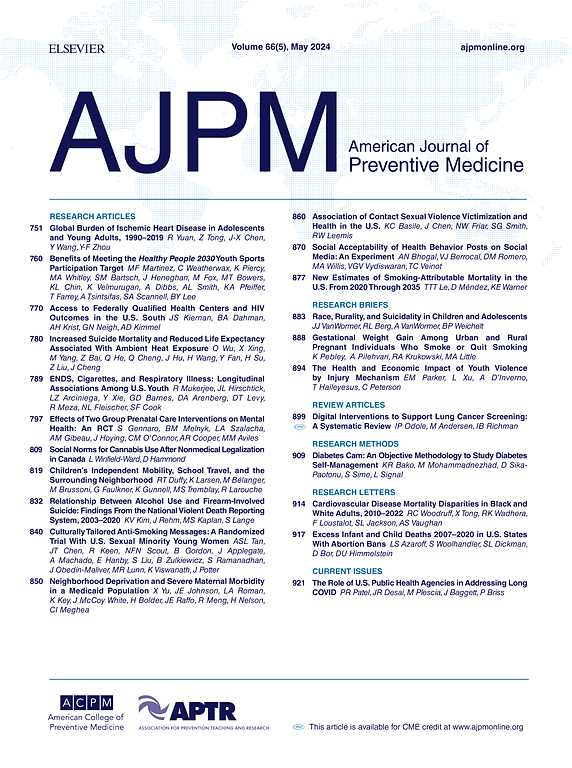Transformation and Development of the Wellness Industry in Resource-based Cities Driven by Healthy Lifestyles: A Case Study of Panzhihua, China
IF 4.5
2区 医学
Q1 MEDICINE, GENERAL & INTERNAL
引用次数: 0
Abstract
Background
In recent years, alongside the continuous advancement of socioeconomic development, the global trend of industrial convergence has become increasingly prominent. The integration of the sports industry with wellness-preservation industries demonstrates significant value in enhancing market efficiency, diversifying service portfolios, and leveraging demographic aging as a strategic catalyst to propel the in-depth evolution of wellness sectors.
Method
Employing methodologies such as in-depth interviews and ASEB grid analysis, this study systematically examines the developmental pathways for wellness-oriented transformation in resource-based cities.
Results
Taking Panzhihua as a case study, the city’s wellness transformation process exemplifies how policy opportunities, institutional safeguards, and talent development can synergize to deepen industrial collaboration, technological integration, and regulatory guidance. These efforts culminate in a sports-wellness industrial model with Chinese characteristics, aligning with the national fitness strategy while driving the industry toward diversification and value-added sophistication.
Conclusions
The key conclusions are as follows: 1. The convergence of sports and wellness industries constitutes an innovative economic phenomenon under the "Sports + Wellness" paradigm. 2. Sustainable integration requires establishing a "sports-to-wellness reciprocity mechanism." This involves categorizing sports-wellness resources, developing specialized markets, and constructing cross-industry platforms to achieve consumption upgrading and structural optimization. 3. Cultivating healthy lifestyles from a wellness industry perspective necessitates a dual "hardware + culture" model, integrating infrastructure development with cultural embeddedness.
健康生活方式驱动的资源型城市健康产业转型与发展——以攀枝花市为例
近年来,随着社会经济发展的不断推进,全球产业融合趋势日益突出。体育产业与健康保存产业的整合在提高市场效率、多样化服务组合以及利用人口老龄化作为推动健康产业深度发展的战略催化剂方面具有重要价值。方法采用深度访谈和ASEB网格分析等方法,系统考察资源型城市健康转型的发展路径。结果以攀枝花市为例,阐述了政策机遇、制度保障和人才发展如何协同推进产业协作、技术融合和监管引导。这些努力最终形成了具有中国特色的体育健康产业模式,与国家健身战略相一致,同时推动产业走向多元化和增值化。主要结论如下:体育与健康产业的融合构成了“体育 + 健康”范式下的创新经济现象。2. 可持续整合需要建立“体育-健康互惠机制”。这包括对体育健康资源进行分类,开发专业市场,构建跨行业平台,实现消费升级和结构优化。3. 从健康产业的角度培育健康的生活方式,需要双重“硬件 + 文化”模式,将基础设施建设与文化嵌入相结合。
本文章由计算机程序翻译,如有差异,请以英文原文为准。
求助全文
约1分钟内获得全文
求助全文
来源期刊

American Journal of Preventive Medicine
医学-公共卫生、环境卫生与职业卫生
CiteScore
8.60
自引率
1.80%
发文量
395
审稿时长
32 days
期刊介绍:
The American Journal of Preventive Medicine is the official journal of the American College of Preventive Medicine and the Association for Prevention Teaching and Research. It publishes articles in the areas of prevention research, teaching, practice and policy. Original research is published on interventions aimed at the prevention of chronic and acute disease and the promotion of individual and community health.
Of particular emphasis are papers that address the primary and secondary prevention of important clinical, behavioral and public health issues such as injury and violence, infectious disease, women''s health, smoking, sedentary behaviors and physical activity, nutrition, diabetes, obesity, and substance use disorders. Papers also address educational initiatives aimed at improving the ability of health professionals to provide effective clinical prevention and public health services. Papers on health services research pertinent to prevention and public health are also published. The journal also publishes official policy statements from the two co-sponsoring organizations, review articles, media reviews, and editorials. Finally, the journal periodically publishes supplements and special theme issues devoted to areas of current interest to the prevention community.
 求助内容:
求助内容: 应助结果提醒方式:
应助结果提醒方式:


